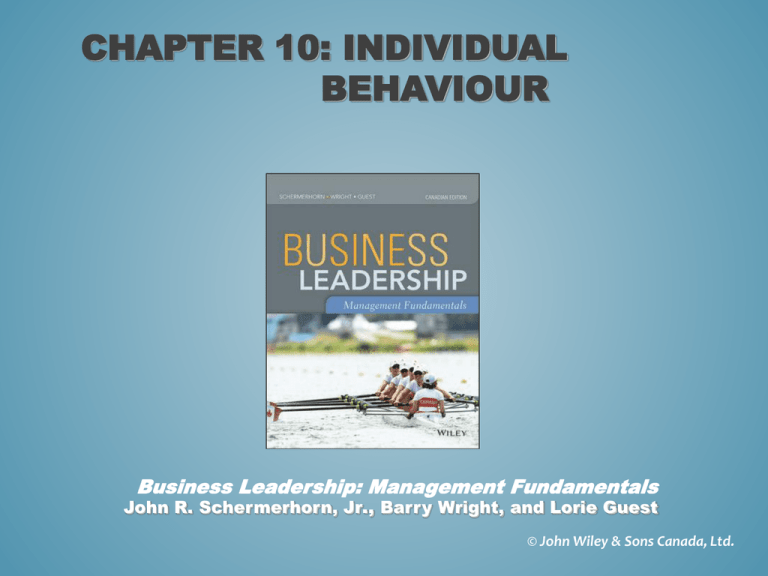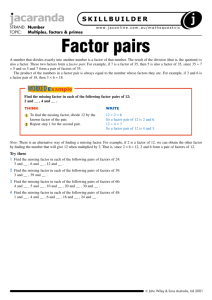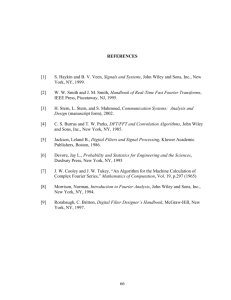
CHAPTER 10: INDIVIDUAL
BEHAVIOUR
Business Leadership: Management Fundamentals
John R. Schermerhorn, Jr., Barry Wright, and Lorie Guest
© John Wiley & Sons Canada, Ltd.
PLANNING
AHEAD —
CHAPTER 10
LEARNING
GOALS
o Describe how perceptions influence
individual behaviour.
o Explain what we should know about
personalities in the workplace.
o Describe how attitudes influence
individual behaviour.
o Explain the dynamics of emotions,
moods, and stress.
PERCEPTION
• The process through which people receive, organize and
interpret information from the environment
• People can perceive the same things or situations differently
• People behave on the basis of their perceptions
© John Wiley & Sons Canada Ltd.
PSYCHOLOGICAL CONTRACTS
• Person-job fit begins here
• A set of expectations held by an individual about what will
be given and received in the employment relationship
• An ideal work situation is one with a fair psychological
contract
– Balance of contributions and inducements.
© John Wiley & Sons Canada Ltd.
FIGURE 10.1 COMPONENTS IN THE
PSYCHOLOGICAL CONTRACT
© John Wiley & Sons Canada Ltd.
PERCEPTUAL TENDENCIES AND
DISTORTIONS
• Stereotypes:
– Occur when someone is identified with a group or category,
and then oversimplified attributes associated with the group
or category are used to describe the individual
• Halo Effects:
– Occur when one attribute is used to develop an overall
impression of a person or situation
© John Wiley & Sons Canada Ltd.
PERCEPTUAL TENDENCIES AND
DISTORTIONS (CONT’D)
• Selective Perception:
– The tendency to single out for attention those aspects of a
situation or attributes of a person that reinforce or appear
consistent with one’s existing beliefs, values, or needs
• Projection
– The assignment of personal attributes to other individuals
© John Wiley & Sons Canada Ltd.
IMPRESSION MANAGEMENT
• The systematic attempt influences how others perceive us. To
inspire a positive influence:
– Dress to convey favourable appeal
– Flatter others to generate positive feelings
– When conversing, make eye contact and smile
– Display a high level of energy
© John Wiley & Sons Canada Ltd.
PERSONALITY
• The combination or overall profile of characteristics that makes
one person unique from others
© John Wiley & Sons Canada Ltd.
“BIG FIVE” PERSONALITY TRAITS
• Extroversion:
– The degree to which someone is outgoing, sociable, and assertive
• Agreeableness:
– The degree to which someone is good-natured, cooperative, and
trusting
• Conscientiousness:
– The degree to which someone is responsible, dependable, and
careful
• Emotional stability:
– The degree to which someone is relaxed, secure, and unworried
• Openness:
– The degree to which someone is curious, receptive to new things,
and open to change
© John Wiley & Sons Canada Ltd.
STUDY QUESTION 2: WHAT SHOULD WE
KNOW ABOUT PERSONALITIES IN THE
WORKPLACE?
• Myers-Briggs Type Indicator:
– Extraverted vs. Introverted: whether a person is drawn
towards external stimulation and is energised by socialising
or prefers independent contemplation and is energised by
solitude
– Sensing vs. Intuitive: whether a person tends to focus on
details or on the big picture in dealing with problems
– Thinking vs. Feeling: whether a person tends to rely on logic
or emotions in dealing with decision making
– Judging vs. Perceiving: whether a person prefers order and
control, or acts with flexibility and spontaneity
© John Wiley & Sons Canada Ltd.
ADDITIONAL PERSONALITY TRAITS
• Locus of Control:
– The extent to which people believe they are in control of
their destinies versus believing that that what happens to
them is beyond their control
• Authoritarianism:
– The degree to which a person defers to authority and
accepts status differences
• Machiavellianism:
– The extent to which someone is emotionally detached and
manipulative in using power
© John Wiley & Sons Canada Ltd.
ADDITIONAL PERSONALITY TRAITS
(CONT’D)
• Self-monitoring:
– The degree to which someone is able to adjust and modify
behaviour in response to the situation and external factors
• Type A Personality:
– A person oriented toward extreme achievement, impatience,
and perfectionism
© John Wiley & Sons Canada Ltd.
FIGURE 10.4 THE “BIG FIVE” & FIVE MORE
PERSONALITY DIMENSIONS THAT INFLUENCE
HUMAN BEHAVIOUR AT WORK
ATTITUDES AND BEHAVIOUR
• Attitude:
– A predisposition to act in a certain way toward people and
things in one’s environment
• Components of Attitudes:
– Cognitive component
– Affective or emotional component
– Behavioural component
• Cognitive Dissonance:
– The discomfort a person feels when attitudes and behaviour
are inconsistent
© John Wiley & Sons Canada Ltd.
JOB SATISFACTION
• Job Satisfaction:
– The degree to which an individual feels positively or
negatively about various aspects of work
– Common aspects of job satisfaction:
• Work itself
• Supervision
• Co-workers
• Advancement opportunities
• Pay
• Work conditions
• Security
• Strong and positive relationship between satisfaction and
absenteeism and turnover
© John Wiley & Sons Canada Ltd.
ORGANIZATIONAL CITIZENSHIP
• Organizational Citizenship:
– Willingness to “go beyond the call of duty” or “go the extra
mile” in one’s work
– Employees accomplish tasks not necessarily required of them
© John Wiley & Sons Canada Ltd.
EMOTIONS, MOODS, AND STRESS
• Three Aspects of Individual Psychology:
– Emotions: a strong feeling directed toward someone or
something
– Moods: generalized positive and negative feelings or states
of mind that may persist for some time
– Stress: a state of tension experienced by individuals facing
extraordinary demands, constraints, or opportunities
© John Wiley & Sons Canada Ltd.
SOURCES OF STRESS
• Stressors:
– Are things that cause stress
– Originate in work, personal, and non-work situations
– Have the potential to influence work attitudes, behaviour,
job performance, and health
© John Wiley & Sons Canada Ltd.
WORK FACTORS AS POTENTIAL
STRESSORS
• Includes:
– Excessively high or low task demands
– Role conflicts or ambiguities
– Poor interpersonal relationships
– Too slow or too fast career progress
• Work-related stress syndromes:
– Set up to fail
– Mistaken identity
© John Wiley & Sons Canada Ltd.
CONSEQUENCES OF STRESS
• Constructive Stress:
– Acts as a positive influence
– Can be energizing and performance enhancing
• Destructive Stress:
– Acts as a negative influence
– Breaks down a person’s physical and mental systems
– Can lead to job burnout and/or workplace rage
© John Wiley & Sons Canada Ltd.
FIGURE 10.9 POTENTIAL NEGATIVE
CONSEQUENCES OF A DESTRUCTIVE
JOB STRESS-BURNOUT CYCLE
© John Wiley & Sons Canada Ltd.
STRESS MANAGEMENT
• Personal wellness:
– The pursuit of positive personal and mental potential though
a health-promotion program
– A form of preventative stress management
– Enables people to be better prepare and deal with stress
© John Wiley & Sons Canada Ltd.
COPYRIGHT
Copyright © 2013 John Wiley & Sons Canada, Ltd. All rights reserved. Reproduction or
translation of this work beyond that permitted by Access Copyright (The Canadian
Copyright Licensing Agency) is unlawful. Requests for further information should be
addressed to the Permissions Department, John Wiley & Sons Canada, Ltd. The
purchaser may make back-up copies for his or her own use only and not for
distribution or resale. The author and the publisher assume no responsibility for errors,
omissions, or damages caused by the use of these programs or from the use of the
information contained herein.
© John Wiley & Sons Canada Ltd.



